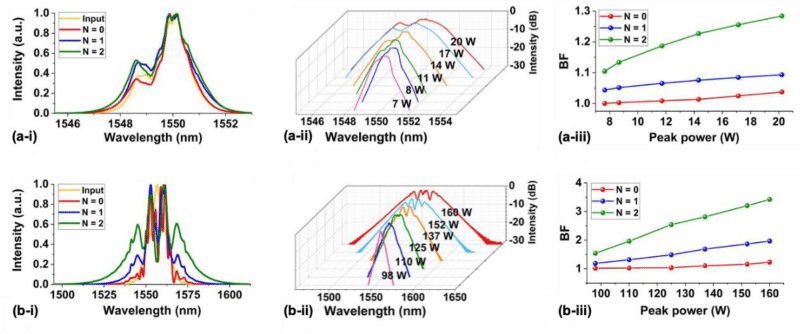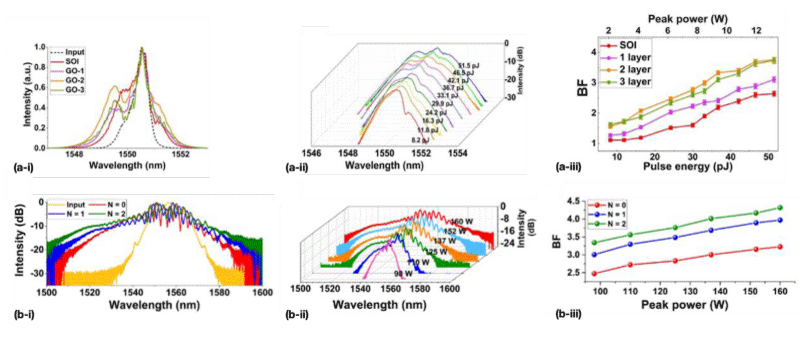Annals of Mathematics and Physics
Graphene oxide-based waveguides for enhanced self-phase modulation
Yuning Zhang1*, Jiayang Wu1, Yang Qu1, Linnan Jia1, Baohua Jia2 and David Moss1
2School of Science, RMIT University, Melbourne, VIC 3000, Australia
Cite this as
Zhang Y, Wu J, Qu Y, Jia L, Jia B, et al. (2022) Graphene oxide-based waveguides for enhanced self-phase modulation. Ann Math Phys 5(2): 103-106. DOI: 10.17352/amp.000048Copyright Licence
© 2022 Zhang Y, et al. This is an open-access article distributed under the terms of the Creative Commons Attribution License, which permits unrestricted use, distribution, and reproduction in any medium, provided the original author and source are credited.The enhanced self-phase modulation (SPM) in silicon nitride (Si3N4) and silicon (Si) waveguides integrated with graphene oxide (GO) films is experimentally demonstrated. By using both picosecond and femtosecond optical pulses, we observe significant spectral broadening in the waveguides due to the high Kerr nonlinearity of GO films. The maximum broadening factors of up to ~3.4 and ~4.3 are achieved in GO-coated Si3N4 waveguides and GO-coated Si waveguides, respectively. The spectral broadening for femtosecond pulses is more significant than the picosecond pulses, which can be attributed to their relatively high peak power. These results show the strong potential of GO films for improving the Kerr nonlinearity of photonic devices.
Introduction
Self-Phase Modulation (SPM) is one of the most important third-order nonlinear optical processes that occur in a nonlinear medium [1-3], which has been widely used in many applications, such as optical spectroscopy [4,5], optical logic gates [6,7], optical diodes [8,9] and optical coherence tomography [10,11].
The on-chip integrated photonic devices based on SPM will reap attractive benefits of compact footprint, high stability, high scalability, low power consumption, and low-cost mass production [12-15]. Although silicon (Si) has been a leading device platform for integrated photonics [16-18], its strong two-photon absorption (TPA) at near-infrared wavelengths results in a low nonlinear figure-of-merit (FOM), which significantly hinders the improvement of SPM performance in Si devices at the telecom band. To address this, other complementary metal-oxide-semiconductor (CMOS) compatible integrated platforms such as silicon nitride (Si3N4) and high-index doped silica glass (Hydex) have been utilized for nonlinear optics owing to their low TPA in this wavelength range.
To overcome the limitations of these existing platforms and improve their nonlinear optical performance, the on-chip integration of two-dimensional (2D) materials with ultrahigh Kerr nonlinearity has been proposed [19-22]. Amongst the different 2D materials, GO has shown many advantages due to its distinct optical properties, including a high Kerr nonlinearity, relatively low loss, facile synthesis processes, and high compatibility with CMOS fabrication.
Here, the enhanced SPM in Si3N4 and Si waveguides integrated with GO films by using both picosecond and femtosecond optical pulses is experimentally reported. Owing to the high Kerr nonlinearity of GO, the hybrid waveguides show significantly improved spectral broadening compared to the uncoated waveguide, achieving the maximum broadening factor (BF) of up to ~3.4 [23] and ~4.3 [24] for the hybrid Si3N4 and Si waveguides, respectively. These results verify the effectiveness of on-chip integrating 2D GO films to improve the SPM performance of photonic devices.
Device fabrication and characterization
Figure 1 (a-i) shows a schematic cross-section of the GO-coated Si3N4 waveguide and Figure 1 (a-ii) shows the corresponding transverse electric (TE) mode profile [23]. The interaction between light and the GO film possessing an ultrahigh Kerr nonlinearity can be excited by the waveguide evanescent field, which underpins the enhancement of the SPM response in the hybrid waveguide. Figure 1(a-iii) shows a microscope image of a Si3N4 integrated chip uniformly coated with a monolayer GO film, where the coated GO film exhibits good morphology, high transmittance, and high uniformity. Figure 1(b) shows a schematic cross-section, TE mode profile, and a microscope image of a Si waveguide uniformly coated with a monolayer GO film [24].
SPM experimental measurement and results
We used both picosecond (~1.9 ps & ~3.9 ps) and femtosecond (~180 fs) optical pulses to perform SPM measurements on the GO-coated Si3N4 waveguides and SOI nanowires [23-25]. Picosecond and femtosecond optical pulses generated by pulsed fiber lasers were delivered into the hybrid waveguides, with a VOA to tune the input pulse energy. Figures 2(a) and 3(a) show the SPM experimental results for GO-coated Si3N4 and Si waveguides with picosecond optical pulses, respectively [23,25]. To compare with the picosecond optical pulses, we also show the results with femtosecond optical pulses in Figures 2(b) and 3(b) [23,24]. In each Figure, (i) shows normalized spectra of optical pulses before and after propagation through the hybrid waveguides with different layers of GO. The output spectra after propagating through the hybrid waveguides show more significant spectral broadening, reflecting the improved SPM performance in these devices. (ii) shows optical spectra measured at different input peak powers for the hybrid waveguides with 2 layers of GO and (iii) shows BFs of the measured output spectra versus input peak power for the hybrid waveguides with different layers of GO. In (i) and (iii), the corresponding results for the uncoated waveguides are also shown for comparison. As expected, the spectral broadening of the output spectra becomes more significant as the peak power increases. We achieved the maximum BF of up to ~3.4 for the GO-coated Si3N4 waveguides and ~4.3 for the GO-coated Si waveguides. Meanwhile, we also observe that the spectral broadening for femtosecond optical pulses is more significant than the picosecond pulses due to their high peak power.
Conclusion
An enhanced SPM-induced spectral broadening of both picosecond and femtosecond optical pulses after propagation through Si3N4 and Si waveguides integrated with 2D GO films is demonstrated. By using a solution-based, transfer-free coating method, we achieve the integration of GO films onto waveguides with precise control of the film thickness. A detailed SPM measurement using the fabricated devices is performed, achieving a maximum BF of ~3.4 and ~4.3 for the Si3N4 and Si devices with two layers of GO, respectively. Finally, the results for the picosecond and femtosecond optical pulses are compared. This work verifies the effectiveness of improving the nonlinear performance of CMOS-compatible photonic devices through the integration of 2D GO films.
- Stolen RH, Lin C. Self-phase-modulation in silica optical fibers. Phys Rev A. 1978; 17: 1448.
- Agrawal GP, Olsson NA. Self-phase modulation and spectral broadening of optical pulses in semiconductor laser amplifiers. IEEE J Quantum Electron. 1989; 25: 2297-2306.
- Wu L, Yuan X, Ma D, Zhang Y, Huang W, Ge Y, Song Y, Xiang Y, Li J, Zhang H. Recent Advances of Spatial Self-Phase Modulation in 2D Materials and Passive Photonic Device Applications. Small. 2020 Sep;16(35):e2002252. doi: 10.1002/smll.202002252. Epub 2020 Jul 30. PMID: 32734683.
- Hult J, Watt RS, Kaminski CF. High bandwidth absorption spectroscopy with a dispersed supercontinuum source. Opt Express. 2007 Sep 3;15(18):11385-95. doi: 10.1364/oe.15.011385. PMID: 19547496.
- Kwarkye K, Jensen M, Engelsholm RD, Dasa MK, Jain D, Bowen P, Moselund PM, Petersen CR, Bang O. In-amplifier and cascaded mid-infrared supercontinuum sources with low noise through gain-induced soliton spectral alignment. Sci Rep. 2020 May 19;10(1):8230. doi: 10.1038/s41598-020-65150-6. PMID: 32427972; PMCID: PMC7237674.
- Wu L. 1D@ 0D hybrid dimensional heterojunction-based photonics logical gate and isolator. Appl Mater Today. 2020; 19: 100589.
- Singh P, Tripathi DK, Jaiswal S, Dixit H. All-Optical Logic Gates: Designs, Classification, and Comparison. Advances in Optical Technologies 2014.
- Dong Y, Chertopalov S, Maleski K, Anasori B, Hu L, Bhattacharya S, Rao AM, Gogotsi Y, Mochalin VN, Podila R. Saturable Absorption in 2D Ti3 C2 MXene Thin Films for Passive Photonic Diodes. Adv Mater. 2018 Mar;30(10). doi: 10.1002/adma.201705714. Epub 2018 Jan 15. PMID: 29333627.
- Konorov S. Experimental demonstration of a photonic-crystal-fiber optical diode. Appl Phys B. 2004; 78: 547-550.
- Moon S, Kim DY. Ultra-high-speed optical coherence tomography with a stretched pulse supercontinuum source. Opt Express. 2006 Nov 27;14(24):11575-84. doi: 10.1364/oe.14.011575. PMID: 19529577.
- Sumimura K, Genda Y, Ohta T, Itoh K, Nishizawa N. Quasi-supercontinuum generation using 1.06 μm ultrashort-pulse laser system for ultrahigh-resolution optical-coherence tomography. Opt Lett. 2010 Nov 1;35(21):3631-3. doi: 10.1364/OL.35.003631. PMID: 21042373.
- Dulkeith E, Vlasov YA, Chen X, Panoiu NC, Osgood RM Jr. Self-phase-modulation in submicron silicon-on-insulator photonic wires. Opt Express. 2006 Jun 12;14(12):5524-34. doi: 10.1364/oe.14.005524. PMID: 19516720.
- Boyraz O, Indukuri T, Jalali B. Self-phase-modulation induced spectral broadening in silicon waveguides. Opt Express. 2004 Mar 8;12(5):829-34. doi: 10.1364/opex.12.000829. PMID: 19474892.
- Tan D, Ikeda K, Sun P, Fainman Y. Group velocity dispersion and self phase modulation in silicon nitride waveguides. Appl Phys Lett. 2010; 96: 061101.
- Duchesne D, Ferrera M, Razzari L, Morandotti R, Little BE, Chu ST, Moss DJ. Efficient self-phase modulation in low loss, high index doped silica glass integrated waveguides. Opt Express. 2009 Feb 2;17(3):1865-70. doi: 10.1364/oe.17.001865. PMID: 19189017.
- Bogaerts W, Chrostowski L. Silicon photonics circuit design: methods, tools and challenges. Laser Photonics Rev. 2018; 12: 1700237. 2018.
- Feng S, Lei T, Chen H, Cai H, Luo X, Poon AW. Silicon photonics: from a microresonator perspective. Laser Photonics Rev. 2012; 6: 145-177.
- Reed GT, Mashanovich G, Gardes FY, Thomson D. Silicon optical modulators. Nat Photonics. 2010; 4: 518-526.
- Gu T. Regenerative oscillation and four-wave mixing in graphene optoelectronics. Nat Photonics. 6: 554-559.
- Autere A, Jussila H, Dai Y, Wang Y, Lipsanen H, Sun Z. Nonlinear Optics with 2D Layered Materials. Adv Mater. 2018 Jun;30(24):e1705963. doi: 10.1002/adma.201705963. Epub 2018 Mar 25. PMID: 29575171.
- Liu W. Recent advances of 2D materials in nonlinear photonics and fiber lasers.Adv Opt Mater. 2020; 8: 1901631.
- Alonso Calafell I, Rozema LA, Alcaraz Iranzo D, Trenti A, Jenke PK, Cox JD, Kumar A, Bieliaiev H, Nanot S, Peng C, Efetov DK, Hong JY, Kong J, Englund DR, García de Abajo FJ, Koppens FHL, Walther P. Giant enhancement of third-harmonic generation in graphene-metal heterostructures. Nat Nanotechnol. 2021 Mar;16(3):318-324. doi: 10.1038/s41565-020-00808-w. Epub 2020 Dec 14. PMID: 33318642.
- Zhang Y. Enhanced self-phase modulation in silicon nitride waveguides integrated with 2D graphene oxide films. IEEE Journal of Selected Topics in Quantum Electronics. 2022.
- Zhang Y, Wu J, Yang Y, Qu Y, Jia L, Jia B, Moss DJ. Enhanced Spectral Broadening of Femtosecond Optical Pulses in Silicon Nanowires Integrated with 2D Graphene Oxide Films. Micromachines (Basel). 2022 May 11;13(5):756. doi: 10.3390/mi13050756. PMID: 35630223; PMCID: PMC9145626.
- Zhang Y, Wu J, Yang Y, Qu Y, Jia L, Moein T, Jia B, Moss DJ. Enhanced Kerr Nonlinearity and Nonlinear Figure of Merit in Silicon Nanowires Integrated with 2D Graphene Oxide Films. ACS Appl Mater Interfaces. 2020 Jul 22;12(29):33094-33103. doi: 10.1021/acsami.0c07852. Epub 2020 Jul 10. PMID: 32597629.
Article Alerts
Subscribe to our articles alerts and stay tuned.
 This work is licensed under a Creative Commons Attribution 4.0 International License.
This work is licensed under a Creative Commons Attribution 4.0 International License.
 Help ?
Help ?

PTZ: We're glad you're here. Please click "create a new query" if you are a new visitor to our website and need further information from us.
If you are already a member of our network and need to keep track of any developments regarding a question you have already submitted, click "take me to my Query."




 Save to Mendeley
Save to Mendeley